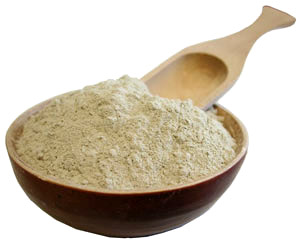Bentonite Clay
Benefits of Bentonite Clay
Though they have been largely forgotten in recent times, healing clays have been used by cultures throughout history for their nutrients and to help rid the body of toxins. Many animals will also turn to eating dirt and clay to help remove poisons from their systems or during times of illness or distress.
Bentonite is one of the most effective and powerful healing clays. Bentonite can be used externally as a clay poultice, mud pack or in the bath and, in skin care recipes like our Montana Mud Scrub. Bentonite Clay is composed of aged volcanic ash. The name comes from the largest known deposit of Bentonite Clay located in Fort Benton, Wyoming, but it is also found in parts of Montana which is where we get ours.
Bentonite Clay is a unique clay due to its ability to produce an “electrical charge” when hydrated. Upon contact with fluid, its electrical components change, giving it the ability to absorb toxins. Bentonite is known for its ability to absorb and remove toxins, heavy meats, impurities and chemicals from your skin. Highly needed in the world we live in today. Bentonite is a swelling clay. When it becomes mixed with water it rapidly swells open like a highly porous sponge. From here the toxins are drawn into the sponge through electrical attraction and once there, they are bound. Bentonite clay carries a strong negative charge which bonds to the positive charge in many toxins. When it comes in contact with a toxin, chemical or heavy metal, the clay will absorb the toxin and release it’s minerals for the body to use. Bentonite also helps get oxygen to cells as it pulls excess hydrogen and allows the cells to replace it with oxygen instead.
People benefit from using Bentonite Clay to help with:
Helping with skin and allergy issues
To help provide minerals for the body
Detoxification
Externally for all types of skin problems and to speed healing
Healing clays like Bentonite have a high concentration of minerals including silica, calcium, magnesium, sodium, iron and potassium.
Even Dr. Weston A Price, in his book “Nutrition and Physical Degeneration” reported that several native cultures including those in the Andes, Central Africa and Australia consumed clays in various ways, most often my carrying balls of dried clay in their bags and dissolving a small amount of the clay in water with meals to prevent poisoning from any toxins present.
In a study from Arizona State University, bentonite clay was found to be highly effective at killing MRSA as well as Salmonella, E.Coli and others.What is promising as research continues in this area is that depending on the method in which the clay kills the infection, it may not be possible for the MRSA or other bacteria to develop a resistance to it as it does with antibiotics.
USES:
Face & Body Scrub: Add enough honey and water to powder to make a smooth paste. Use about 1/2 as much honey as water. Apply thickly to face and body and lightly scrub in small circles. Rinse. .
Apply a paste of Montana Mud Scrub with water and honey added on any skin irritation like blemishes, insect bites, cuts, skin itching or burns. Leave it on until it dries and wash off. This is said to be especially calming to skin itching from eczema, psoriasis, chicken pox, etc.
Skin Poultice for Bites/Burns/Cuts/Stings: For more severe issues, create a poultice by putting a thick layer of clay on the skin and applying a wet gauze or cloth over it. Wrap the area and leave the poultice on, changing every 2 hours.
Detox Bath: Add about 1/4 cup of Montana Mud Scrub, 1 Cup of Milk and 1/4 C of Honey to a bath for a relaxing detox bath that softens skin.
IMPORTANT NOTES: Do not let healing clays like Bentonite come in to contact with anything metal, is this will reduce the effectiveness. This is one of the reasons why we package Montana Mud Scub in a glass jar. After you add in honey & water, stir with a wooden utensil. We use a chop stick.
